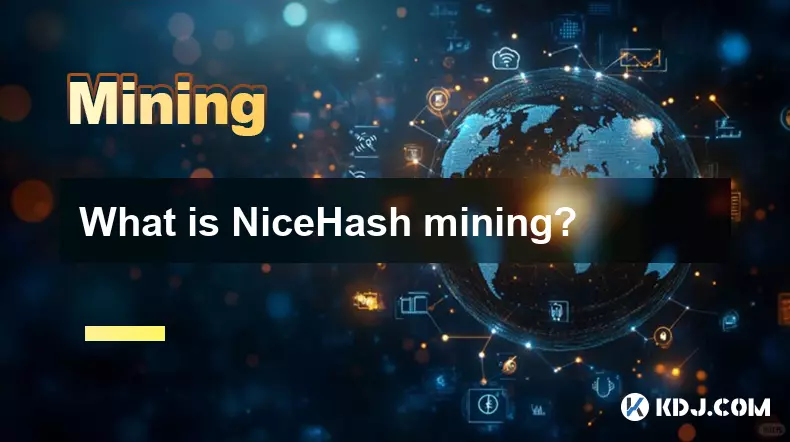-
 bitcoin
bitcoin $103094.926080 USD
3.95% -
 ethereum
ethereum $3398.208576 USD
6.43% -
 tether
tether $0.999971 USD
-0.04% -
 xrp
xrp $2.326205 USD
9.96% -
 bnb
bnb $947.145845 USD
4.46% -
 solana
solana $160.315987 USD
7.54% -
 usd-coin
usd-coin $1.000014 USD
0.01% -
 tron
tron $0.288163 USD
2.37% -
 dogecoin
dogecoin $0.164881 USD
5.50% -
 cardano
cardano $0.536519 USD
7.14% -
 hyperliquid
hyperliquid $40.526327 USD
6.62% -
 chainlink
chainlink $14.898178 USD
5.68% -
 bitcoin-cash
bitcoin-cash $483.923206 USD
4.44% -
 ethena-usde
ethena-usde $0.999280 USD
0.02% -
 stellar
stellar $0.276354 USD
6.32%
The Pro's Guide to Mining Firmware: Essential Upgrades for ASICs and GPUs.
Custom mining firmware like Braiins OS, Vnish, and Hiveon boosts hash rates, efficiency, and control over ASICs and GPUs, but requires careful installation and security practices to avoid risks.
Nov 05, 2025 at 03:39 pm

Understanding Mining Firmware Basics
1. Mining firmware acts as the operating system for ASICs and GPUs, controlling how they interact with blockchain networks. It determines hash rate efficiency, power draw, and thermal management during mining operations.
2. Stock firmware provided by manufacturers often prioritizes stability over performance, limiting overclocking potential and energy optimization features that advanced miners seek.
3. Custom firmware solutions like Vnish, Braiins OS, and Hiveon offer enhanced control over voltage curves, frequency tuning, and fan profiles tailored to specific hardware models.
4. Flashing new firmware requires caution—incorrect procedures can brick devices or void warranties. Always verify compatibility and follow step-by-step guides from trusted sources.
5. Regular updates in custom firmware ecosystems fix bugs, improve pool connectivity, and sometimes introduce support for new algorithms or coins without changing hardware.
Maximizing Hash Rate on ASIC Miners
1. Upgrading to Braiins OS on Bitcoin-compatible ASICs such as Antminer S9 or S19 series enables fine-grained control over frequency settings and power limits through its built-in web interface.
2. Vnish firmware supports advanced hashing modes including 'High Performance' and 'Silent Mode,' allowing operators to balance output against noise and electricity costs depending on deployment environment.
3. Proper cooling becomes critical when pushing ASICs beyond factory defaults. Undervolting combined with optimized airflow can maintain high hash rates while reducing wear on internal components.
4. Some third-party firmwares integrate real-time monitoring tools that display temperature per board, reject rates, and uptime statistics directly on the dashboard.
5. Pool flexibility is another advantage—custom firmware often supports multiple pools simultaneously, enabling failover configurations that prevent downtime during server outages.
Optimizing GPU Mining Efficiency
1. For Ethereum Classic, Ravencoin, or other GPU-mineable blockchains, flashing modified BIOS onto graphics cards using tools like WinFlash allows permanent voltage and clock adjustments without relying on software overlays.
2. Hiveon OS offers a lightweight Linux-based platform designed specifically for GPU farms, supporting up to 16 cards per rig with automated driver installation and remote management via mobile app.
3. Memory timings play a crucial role in algorithmic performance; tweaking tRFC and tRCD values through custom VBIOS can increase memory bandwidth utilization on AMD and NVIDIA GPUs alike.
4. Power limit modifications reduce wattage consumption while maintaining acceptable hashrates, especially beneficial in regions with high electricity pricing or capped supply capacity.
5. Monitoring tools integrated into platforms like MSI Afterburner or embedded within Hiveon provide live feedback on core usage, hotspot temperatures, and average solv/sec metrics across all active devices.
Firmware Security and Stability Considerations
1. Only download firmware from official repositories or verified community channels to avoid malicious code injections that could redirect mining rewards or compromise network access.
2. Maintain backups of original firmware before flashing upgrades. This ensures recovery options if instability arises post-installation or if resale value preservation is needed later.
3. Secure SSH access and change default credentials immediately after installing open-source firmware to prevent unauthorized remote intrusions on mining rigs connected to public IPs.
4. Test new firmware versions on a single device before rolling out fleet-wide updates. Unexpected crashes or incompatibilities can disrupt large-scale operations if not isolated early.
5. Check changelogs thoroughly—some updates may alter default pool settings or require reconfiguration of API keys and worker names used for tracking performance.
Frequently Asked Questions
What happens if I flash incompatible firmware on my miner?Flashing incompatible firmware can result in boot loops, unresponsive interfaces, or complete hardware failure. The device might no longer communicate with the network or accept commands. Recovery often requires JTAG programming or manufacturer-level intervention, which may not be feasible for consumer users.
Can custom firmware increase my profitability significantly?Yes, under optimal conditions. A well-tuned ASIC running Braiins OS+ can achieve 10–15% higher efficiency compared to stock firmware. Similarly, properly flashed GPUs with optimized VBIOS can see improved MH/s per watt ratios, translating into lower operational costs over time.
Is it possible to revert back to factory firmware after using third-party options?In most cases, yes. Manufacturers typically store bootloader partitions separately, allowing restoration via SD card, USB drive, or serial connection. However, some vendors have started locking bootloaders on newer models, making downgrades difficult without exploiting vulnerabilities.
Do mining pools detect or restrict miners using custom firmware?Mining pools do not discriminate based on firmware type. They accept shares as long as they meet cryptographic validation standards. However, abnormal submission patterns (e.g., excessive stale shares) due to unstable overclocking might trigger temporary bans until configuration is stabilized.
Disclaimer:info@kdj.com
The information provided is not trading advice. kdj.com does not assume any responsibility for any investments made based on the information provided in this article. Cryptocurrencies are highly volatile and it is highly recommended that you invest with caution after thorough research!
If you believe that the content used on this website infringes your copyright, please contact us immediately (info@kdj.com) and we will delete it promptly.
- Bitcoin's Dip Below $100K: Expert Says 'No Panic' – Just a Healthy Reset
- 2025-11-06 14:35:01
- Ripple's $500M Raise: Is the $40B Valuation a Nod to XRP's Future?
- 2025-11-06 12:55:01
- Bitcoin, Crypto, Ethereum: Trump's Promise, Social Sentiment & Institutional Adoption
- 2025-11-06 13:25:01
- Dogecoin, Musk, and Moonshots: Decoding the Price Predictions
- 2025-11-06 13:10:01
- Poain BlockEnergy: Pioneering Stability in the Multi-Chain Crypto Landscape
- 2025-11-06 13:10:01
- Kalen DeBoer's Game Day Rituals: Hoodies, Coins, and Crimson Tide Luck
- 2025-11-06 13:10:01
Related knowledge

What is the block reward in mining?
Nov 06,2025 at 12:35am
Understanding Block Rewards in Cryptocurrency Mining1. The block reward is the incentive miners receive for successfully validating and adding a new b...

How do mining algorithms work?
Nov 06,2025 at 04:59am
Mining Algorithms and Their Role in Blockchain Networks1. Mining algorithms serve as the backbone of blockchain consensus mechanisms, ensuring that tr...

What is NiceHash mining?
Nov 06,2025 at 07:40am
NiceHash mining refers to the process of renting out computational power to individuals or organizations seeking to mine cryptocurrencies without owni...

Does an antivirus program affect mining?
Nov 05,2025 at 09:29pm
Understanding Decentralized Exchanges in the Crypto Ecosystem1. Decentralized exchanges (DEXs) operate without a central authority, allowing users to ...

What is the history of Bitcoin mining?
Nov 05,2025 at 08:15pm
Within the fast-moving world of cryptocurrency, new developments emerge daily, reshaping how investors, developers, and institutions interact with dig...

How is the energy consumption of mining justified?
Nov 05,2025 at 10:20pm
Energy Consumption in Cryptocurrency Mining1. The energy consumption associated with cryptocurrency mining has drawn significant attention from enviro...

What is the block reward in mining?
Nov 06,2025 at 12:35am
Understanding Block Rewards in Cryptocurrency Mining1. The block reward is the incentive miners receive for successfully validating and adding a new b...

How do mining algorithms work?
Nov 06,2025 at 04:59am
Mining Algorithms and Their Role in Blockchain Networks1. Mining algorithms serve as the backbone of blockchain consensus mechanisms, ensuring that tr...

What is NiceHash mining?
Nov 06,2025 at 07:40am
NiceHash mining refers to the process of renting out computational power to individuals or organizations seeking to mine cryptocurrencies without owni...

Does an antivirus program affect mining?
Nov 05,2025 at 09:29pm
Understanding Decentralized Exchanges in the Crypto Ecosystem1. Decentralized exchanges (DEXs) operate without a central authority, allowing users to ...

What is the history of Bitcoin mining?
Nov 05,2025 at 08:15pm
Within the fast-moving world of cryptocurrency, new developments emerge daily, reshaping how investors, developers, and institutions interact with dig...

How is the energy consumption of mining justified?
Nov 05,2025 at 10:20pm
Energy Consumption in Cryptocurrency Mining1. The energy consumption associated with cryptocurrency mining has drawn significant attention from enviro...
See all articles























![[4K 60fps] Morcee by DTMaster09 (1 Coin) [4K 60fps] Morcee by DTMaster09 (1 Coin)](/uploads/2025/11/06/cryptocurrencies-news/videos/690bf31847bc1_image_500_375.webp)


















































